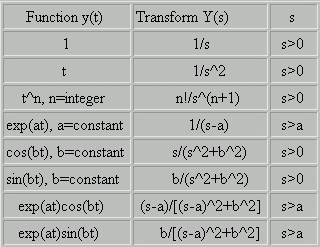Consider the Laplace transform:
![]()
Some manipulations must be done before Y(s) can be inverted since
it
does not appear directly in our table of Laplace transforms.

As we will show below:
![]()
Now, we can invert Y(s). From the table, we see that the inverse
of
1/(s-2) is exp(2t) and that inverse of 1/(s-3) is exp(3t).
Using the
linearity of the inverse transform, we have
![]()
The method of partial fractions is a technique for decomposing
functions
like Y(s) above so that the inverse transform can be
determined in a
straightforward manner. It is applicable to
functions of the form
![]()
where Q(s) and P(s) are polynomials and the degree of
Q is less than
the degree of P. For simplicity we assume that
Q and P have real
coefficients. We consider the following cases:
P(s) is a Quadratic with 2 Real Roots
Consider the initial example on this page:
![]()
The denominator can be factored: s^2-5s+6=(s-2)(s-3). The
denominator
has 2 real roots. In this case we can write
![]()
Here A and B are numbers. This is always possible if the
numerator is
of degree 1 or is a constant. The goal now is
to find A and B. Once we
find A and B, we can invert
the Laplace transform:
![]()
If we add the two terms on the RHS, we get
![]()
Comparing the LHS and RHS, we have:
![]()
The denominators are equal. The two sides will be equal if the
numerators
are equal. The numerators are equal for
all s if the coefficients of s and the
constant term
are equal. Hence, we get the following equations:
![]()
This is a system of 2 linear equations with 2 unknowns. It
can be
solved by standard methods. We obtain A=4 and B=-2.
Hence
![]()
If the denominator has n distinct roots:
![]()
then the decomposition has the form
![]()
where A_1, A_2, ..., A_n are unknown numbers. The inverse
transform is
![]()
The unknown coefficients can be determined using the
same
technique as in the case of only 2 factors, as shown
above.
P(s) is a Quadratic with a Double Root
Consider the example:
![]()
The denominator has double root -2. The appropriate decomposition
in this case is
![]()
Here A and B are numbers. From the table the inverse transform
of 1/(s+2) is exp(-2t) and the inverse transform of
1/(s+2)^2 is
texp(-2t). Hence, the inverse transform of
Y(s) is
![]()
Using the same technique as in the case of distinct roots
above,
it can be shown that A=1 and B=-2.
P(s) is a Quadratic and has Complex Conjugate Roots
Consider the example:
![]()
The roots of the denominator are -2+/-i. We can complete the
square for the denominator. We have
![]()
Hence, we have
![]()
Note the denominator (s+2)^2+1 is similar to that for
Laplace
transforms of exp(-2t)cos(t) and exp(-2t)sin(t).
We need to
manipulate the numerator. Note that in the
formula in the table,
we have a=-2 and b=1. We look
for a decomposition of the form
![]()
If we can find A and B, then:
![]()
The inverse transform is
![]()
We can determine A and B by equating numerators in the expression
![]()
Comparing coefficients of s in the numerator we
conclude 3=A.
Comparing the constant terms we
conclude 2A+B=9. Hence
A=3 and B=3.
P(s) is of Degree 3 and has 1 Real Root and 2 Complex
Conjugate
Roots
Consider the example:
![]()
The roots of the denominator are 1 and -2+/-i. In this case
we
look for a decomposition of the form:
![]()
where A, B and C are unknowns. The inverse transform
of A/(s-1)
is Aexp(t). Once B and C are determined the
second term can be
manipulated as in the previous example.
[ODE Home] [1st-Order Home] [2nd-Order Home] [Laplace Transform Home] [Notation] [References]
Copyright © 1996 Department of Mathematics, Oregon State University
If you have questions or comments, don't hestitate to contact us.